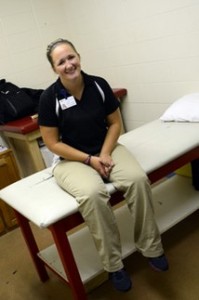The Most Important Spectator
- Share
- Tweet
- Pin
- Share

Athletic trainer Lauren Mulder finds that communication and education are important tools in her profession.
Imagine being an expert in a field where accurate, instinctual, and swift assessment is simply an expectation. Then imagine making those assessments and decisions in front of plenty of onlookers – sometimes bleachers full of crazy sports fans. For athletic trainers, this is just another day on the job.
In Door County, athletic trainers are either on site or on call for most high school athletic events, and when an injury occurs, they are always the first to know. This makes them the most important spectator in any crowd and, oftentimes, the most important contact in any coach’s phonebook.
Whether it is a sprained joint, a broken bone, or a heavy bruise, the athletic trainer is always involved, even if they are many times overlooked until the moment they are most urgently needed.
Yet, athletic training is not always considered a pressure-filled, high status profession by the masses. Ministry Door County Medical Center Director of Rehab Deb Whitelaw-Gorski views the occupation quite differently.
“When it comes to skill level, it is right on line with emergency room staff, emergency medical technicians, and paramedics,” Whitelaw-Gorski said. “They are definitely all of the same caliber.”
When it comes to long-term care, athletic trainers are even more involved. Many times, they hold stronger relationships with their patients simply because they have to. Attending practices, games, and rehab sessions can add up many ours of personal interaction.

Athletic Trainer Rachel Cruz assesses an athlete’s injury on the field during a Sevastopol football game.
Whitelaw-Gorski points to these relationships as key beneficial factors in the process of injury management.
“The relationships held not only with athletes, but with parents and coaches is paramount,” Whitelaw-Gorski noted. “If they have not gained the respect of the coaches or the parents, there will be more room for disagreement.”
Disagreement can make for a sticky situation in which the athletic trainer is essentially a middleman between injury and physician. Ministry athletic trainer Lauren Mulder said the keys to performing her job and avoiding that middleman situation are communication and education.
“Overall education helps the situation of an injury,” Mulder said. “We have to let [the injured person] know exactly what could happen if they don’t take the injury seriously.”
“Communication is also huge to athletic training,” Mulder continued. “We can relate information from past experiences to answer questions and misunderstandings from what a doctor may have said. In the end, we end up relaying all the information to coaches, athletes, parents, and possibly even teachers.”
On the high school level, the trainer-athlete relationship is heightened to a greater level and can lead to an even trickier phase of athletic training. As athletes themselves, trainers understand injury from a personal and professional standpoint. They may be witnessing a friend become injured, but then must do all they can to help that friend return healthy.
“Initially, you have to have empathy for the kid,” Mulder stated. “But then you move on to a place where you can get through [the injury] together and get them back out on the field.”
With “the field” as the final goal to a sometimes quick – and other times lengthy – process, the athletic trainer is ever apparent throughout.
Ministry Door County Medical Center provides athletic training services for Door County’s high schools. For more information, visit http://ministryhealth.org/DCMH/home.nws or call 920.743.5566.

